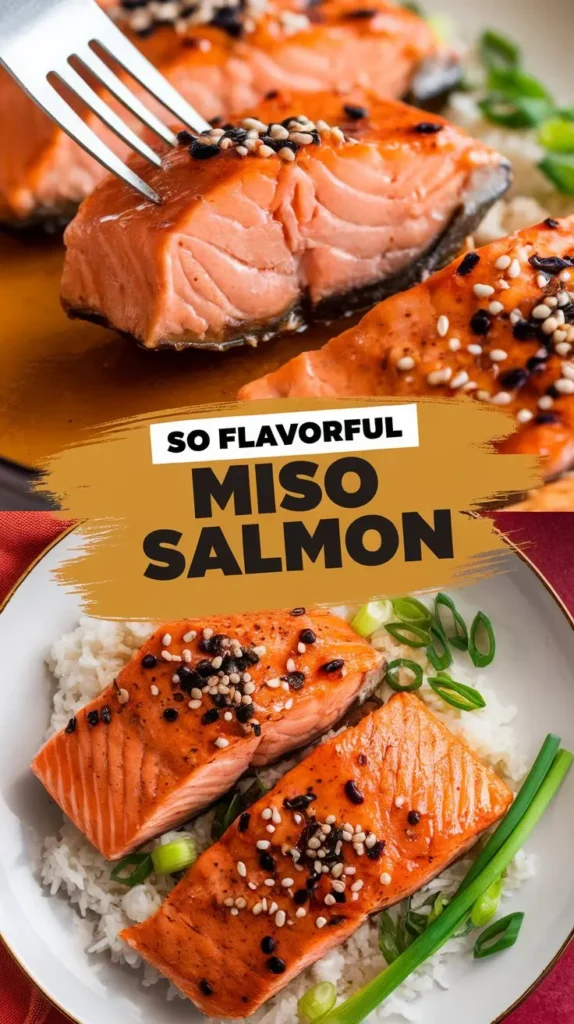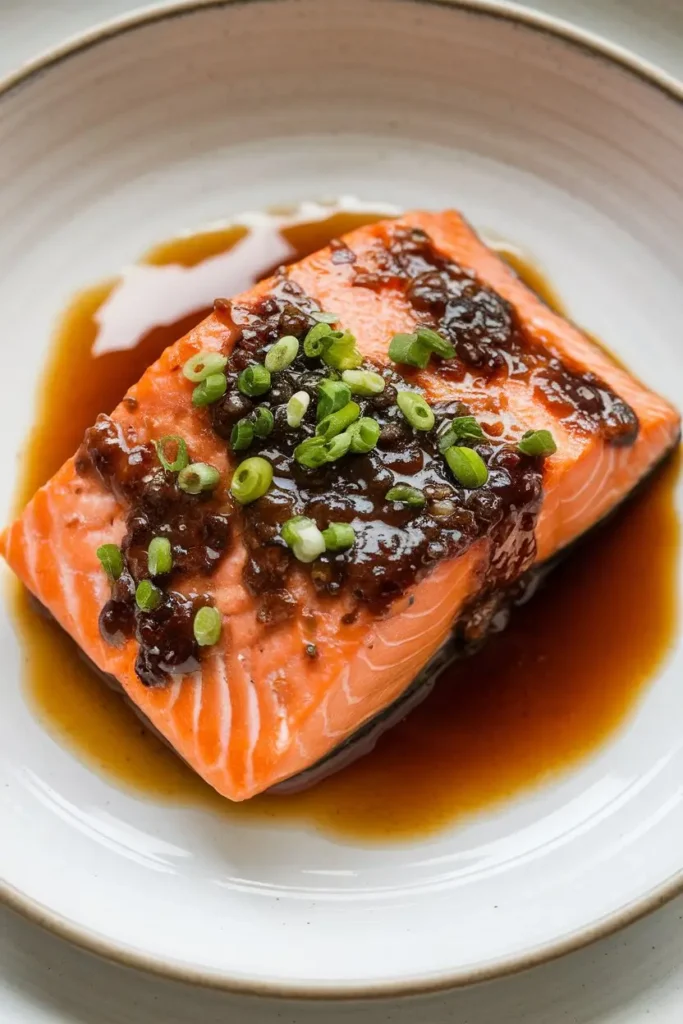You can create a restaurant-caliber dinner in less than the time it takes to scroll a delivery app. And it starts with the quiet power of umami.
Introduction
If the USDA recommends cooking fish to 145 F, why do many chefs pull salmon at 120 to 125 F for peak tenderness, and how does a 15 minute marinade still deliver big flavor? That tension between safety guidance and culinary practice is exactly where miso salmon shines.
Short marinade, high-heat finish, and a savory-sweet glaze that coats every flake of fish. Miso salmon brings deep umami without fuss, and it lands on the table fast enough for a weeknight. With smart technique, you get glossy caramelization, juicy fillets, and balanced seasoning that pairs with rice, roasted vegetables, or a crisp salad.
Along the way, we will cover precise cook times, ingredient swaps, and healthier tweaks. You will also find nutrition insights, storage tips, and chef-level tricks to dial in that perfect miso glaze.
Ingredients List
This version leans classic with white miso and a broiled finish that guarantees lightly charred edges and a tender center.
- 4 salmon fillets, 5 to 6 ounces each, skin-on preferred
- 3 tablespoons white miso paste (shiro miso)
- 1 tablespoon red miso paste (aka miso) for depth, optional
- 1 tablespoon low-sodium soy sauce or tamari
- 1 tablespoon mirin
- 1 tablespoon rice vinegar
- 1 tablespoon honey or maple syrup
- 1 teaspoon toasted sesame oil
- 1 teaspoon finely grated fresh ginger
- 1 small garlic clove, finely grated
- 1 to 2 teaspoons water, as needed to thin the glaze
- 1 teaspoon neutral oil for the pan, or use parchment
- Garnish: thinly sliced scallions, toasted sesame seeds, lime or lemon wedges
Substitutions and smart swaps:
- Fish choice: Sockeye and coho stay firm and bright. Atlantic salmon runs richer and more forgiving. Steelhead trout works nicely too.
- Miso styles: White miso is mild and slightly sweet. Red miso is saltier and stronger. If using only red miso, cut the soy sauce by half.
- Sweetener: Honey, maple, brown sugar, agave, or an allulose blend for low sugar.
- Gluten-free: Use tamari or coconut aminos. If using coconut aminos, reduce the honey slightly since aminos add sweetness.
- Low sodium: Choose white miso, low-sodium tamari, and add an extra teaspoon of water to the glaze.
- Aromatics: Add a pinch of chili flakes or 1 teaspoon gochujang for gentle heat.
Timing
- Prep time: 10 minutes
- Marinating time: 15 to 30 minutes
- Cook time: 6 to 9 minutes under the broiler
- Rest time: 3 minutes
- Total time: About 33 to 52 minutes, depending on how long you marinate
Context that helps planning:
- Many miso fish recipes recommend an overnight marinade. Testing shows a 15 to 30 minute window still penetrates the surface and builds a lacquered finish once broiled, with less risk of over-salting.
- Broiling at high heat shortens cook time by around 30 to 50 percent compared with baking at 375 F, while keeping the interior moist.

Step-by-Step Instructions
Step 1: Make the miso glaze
In a small bowl, whisk the white miso, optional red miso, soy or tamari, mirin, rice vinegar, honey, sesame oil, ginger, and garlic. If the mixture is very thick, splash in 1 to 2 teaspoons of water. You are aiming for a glossy, spreadable paste that clings to a spoon.
Pro tip: Taste for balance. If it is too salty, add a touch more honey or water. If it is too sweet, add 1 teaspoon rice vinegar. If it is flat, a pinch of salt can actually amplify umami.
Step 2: Prep the salmon
Pat the salmon dry with paper towels on all sides. Dry surface equals better caramelization. If your fillets are uneven, fold thin belly portions under so the pieces cook evenly.
Pro tip: Pinbone check. Run your finger along the flesh and use tweezers to pull any stray bones.
Step 3: Marinate briefly
Spread half of the glaze over the top and sides of the salmon. Reserve the rest for brushing later. Set the fillets in a shallow dish, skin side down, and marinate 15 to 30 minutes at room temperature, or up to 4 hours in the fridge.
Pro tip: If marinating longer than 30 minutes, cover and refrigerate, then bring the fillets to room temperature for 10 to 15 minutes before cooking.
Step 4: Position the rack and preheat the broiler
Place an oven rack about 6 inches from the broiler element. Line a sheet pan with foil and lightly oil it, or use parchment rated for high heat.
Pro tip: Preheat for a full 5 minutes so the heat is fierce from the start. This is key for that lacquered top.
Step 5: Broil to glossy perfection
Arrange the salmon skin side down. Broil 6 to 9 minutes, depending on thickness, until the glaze bubbles and edges start to char. Aim for an internal temperature of 120 to 125 F for medium, 130 F for medium-well. The center should flake but remain moist.
Pro tip: Different broilers vary. Start checking at minute 5. If any spots darken too fast, move the pan one rack lower or tent a small strip of foil over that area.
Step 6: Brush and rest
Remove from the oven and immediately brush with some of the reserved glaze for shine. Let the salmon rest 3 minutes. Carryover heat helps set the glaze and finish the cook.
Pro tip: Want extra gloss without more sugar? Whisk 1 teaspoon hot water into the remaining glaze and brush a very thin layer after resting.
Step 7: Garnish and finish
Shower with scallions and sesame seeds. Serve with citrus wedges. A squeeze of lime or lemon brightens the miso and cuts through richness.
Alternative cooking paths:
- Air fryer: 390 F for 6 to 8 minutes. Check early.
- Grill: Medium-high, indirect heat with the lid closed, about 8 minutes. Use a well-oiled griddle insert to prevent sticking.
- Pan roast: Sear skin side down in an oven-safe skillet for 3 to 4 minutes, flip, brush glaze, and finish in a 425 F oven for 4 minutes.
Nutritional Information
These values are estimates for one 6 ounce fillet with glaze. Actual values vary by salmon type and glaze thickness.
| Nutrient | Amount per serving |
|---|---|
| Calories | ~460 kcal |
| Protein | ~35 g |
| Total fat | ~23 g |
| Saturated fat | ~5 g |
| Carbohydrates | ~18 g |
| Total sugars | ~14 g |
| Fiber | ~0 g |
| Sodium | ~980 mg |
| Omega-3 fatty acids | ~2.2 g |
| Vitamin D | ~20 to 30% DV |
| Selenium | ~60% DV |
| Potassium | ~15% DV |
Key insights:
- Most of the fat is heart-friendly, driven by EPA and DHA.
- Sodium primarily comes from miso and soy sauce. Use low-sodium tamari and more white miso to reduce the total.
- Honey in the glaze adds quick energy and helps browning. It can be scaled down if needed.
Healthier Alternatives for the Recipe
Dial it to your dietary goals without losing flavor.
- Lower sodium: Use 3 tablespoons white miso only, switch to low-sodium tamari, and add 2 teaspoons water to the glaze. Skip the extra brushing at the end.
- Lower sugar: Cut honey to 1 teaspoon and add 1 teaspoon grated apple or pear to keep a gentle sweetness. Allulose or a monk fruit blend also works.
- Gluten-free: Tamari or coconut aminos, plus gluten-free miso made with chickpeas or rice.
- Dairy-free: No changes needed, the base recipe is dairy-free.
- High protein macro plans: Serve a 7 to 8 ounce fillet and pair with cauliflower rice or steamed greens to keep carbs modest.
- Mediterranean-style twist: Swap honey for date syrup, add extra lemon zest, and finish with chopped parsley and a drizzle of olive oil.
- Spicy option: Whisk in 1 teaspoon sriracha or gochujang for a gentle kick.
Serving Suggestions
Build a plate that feels complete and balanced.
- Base layers
- Steamed jasmine rice, brown rice, or quinoa
- Soba noodles tossed with sesame oil and a splash of rice vinegar
- Cauliflower rice or spiralized zucchini for a lighter base
- Crunch and color
- Quick cucumber salad with rice vinegar, a pinch of sugar, and sesame seeds
- Shaved cabbage slaw with lime and cilantro
- Blistered green beans or charred broccolini
- Sauces and extras
- A light drizzle of extra glaze on the plate, not the fish, to control salt
- Chili crisp or toasted nori strips
- Pickled ginger for brightness
- Drinks
- Off-dry Riesling, Sauvignon Blanc, or a chilled light Pinot Noir
- Sparkling water with lime and a sprig of shiso or mint
Meal prep tip: Turn leftovers into a miso salmon sushi bowl with rice, avocado, cucumbers, edamame, and a spoon of yogurt-mayo mixed with a little sriracha.
Common Mistakes to Avoid
- Over-marinating: Miso is salty. Beyond 4 hours the fish can tighten and taste overly seasoned. Stick to 15 to 30 minutes for weeknights.
- Too close to the broiler: If the fillets sit 3 to 4 inches from the element, glaze can burn before the center cooks. Keep about 6 inches.
- Not drying the fish: Moisture on the surface dilutes the glaze and prevents browning. Pat dry thoroughly.
- Cold fish straight to heat: Very cold fillets cook unevenly. Give them 10 to 15 minutes at room temp after a fridge marinade.
- Using only red miso without adjustments: It can tip salty and bitter. If that is all you have, reduce soy and add 1 to 2 teaspoons of water.
- Overcooking: Past 130 F, the texture firms quickly. Pull at 120 to 125 F and rest.
- Skipping the lined pan: Miso glaze sticks. Use foil or parchment and a light coat of oil for easy cleanup.
Storing Tips for the Recipe
- Fridge: Cooked miso salmon keeps 2 to 3 days in an airtight container. Cool completely before sealing to avoid condensation.
- Freezer: Wrap portions tightly, then place in a freezer bag. Freeze up to 2 months. Defrost overnight in the fridge for best texture.
- Reheating: Warm gently at 275 F for 8 to 10 minutes, or use a covered skillet on low heat. Avoid microwaving at high power to prevent dry edges.
- Make-ahead glaze: The miso glaze keeps 1 week in the fridge. Whisk before using. It also works on cod, tofu, or eggplant.
- Safe marinade practices: Marinated raw fish should not sit at room temperature beyond 30 minutes. If marinating longer, refrigerate. Discard any marinade that touched raw fish, or boil it for 1 minute before using as a sauce.
Conclusion
Fast to make, intensely savory, and endlessly adaptable, this miso salmon delivers restaurant-worthy flavor with weeknight timing. Try it tonight, share your results in the comments, rate the recipe in the review section, and subscribe for new ideas delivered to your inbox.
FAQs
Q: Can I bake instead of broil?
A: Yes. Bake at 425 F for 10 to 12 minutes, brushing halfway with glaze. You will get less char, so switch to broil for the last 1 to 2 minutes if you want deeper color.
Q: Do I need to remove the skin?
A: Skin-on helps protect the flesh from heat and keeps moisture in. After cooking, the skin separates easily if you prefer not to eat it.
Q: Which miso is best?
A: White miso is mild and slightly sweet, great for balance. Red miso is stronger and saltier. A blend gives depth without overwhelming the salmon.
Q: How do I know when it is done without a thermometer?
A: Gently press the top with a fork. If the flakes separate but the center is still moist and glossy, it is ready. The surface should be caramelized, not burned.
Q: Can I make it spicy?
A: Add 1 teaspoon sriracha, gochujang, or a pinch of red pepper flakes to the glaze. Taste and adjust so the heat does not overshadow the miso.
Q: Is this recipe freezer-friendly after cooking?
A: Yes. Cool fully, wrap tightly, and freeze portions. Reheat low and slow to keep the texture tender.
Q: What if I only have soy sauce and miso?
A: You can still make it. Mix miso, soy, a bit of honey or sugar, and a splash of water. The ginger, garlic, and mirin add complexity, but the core flavor will still shine.
Q: Can I use this glaze for tofu or vegetables?
A: Absolutely. Press and bake tofu at 400 F, then brush with glaze and broil briefly. It also works on eggplant, mushrooms, or roasted carrots.
Q: How do I keep the glaze from burning?
A: Keep the rack about 6 inches from the heat, watch closely after minute 5, and do not over-sugar the glaze. If needed, add a splash of water to thin it slightly.


